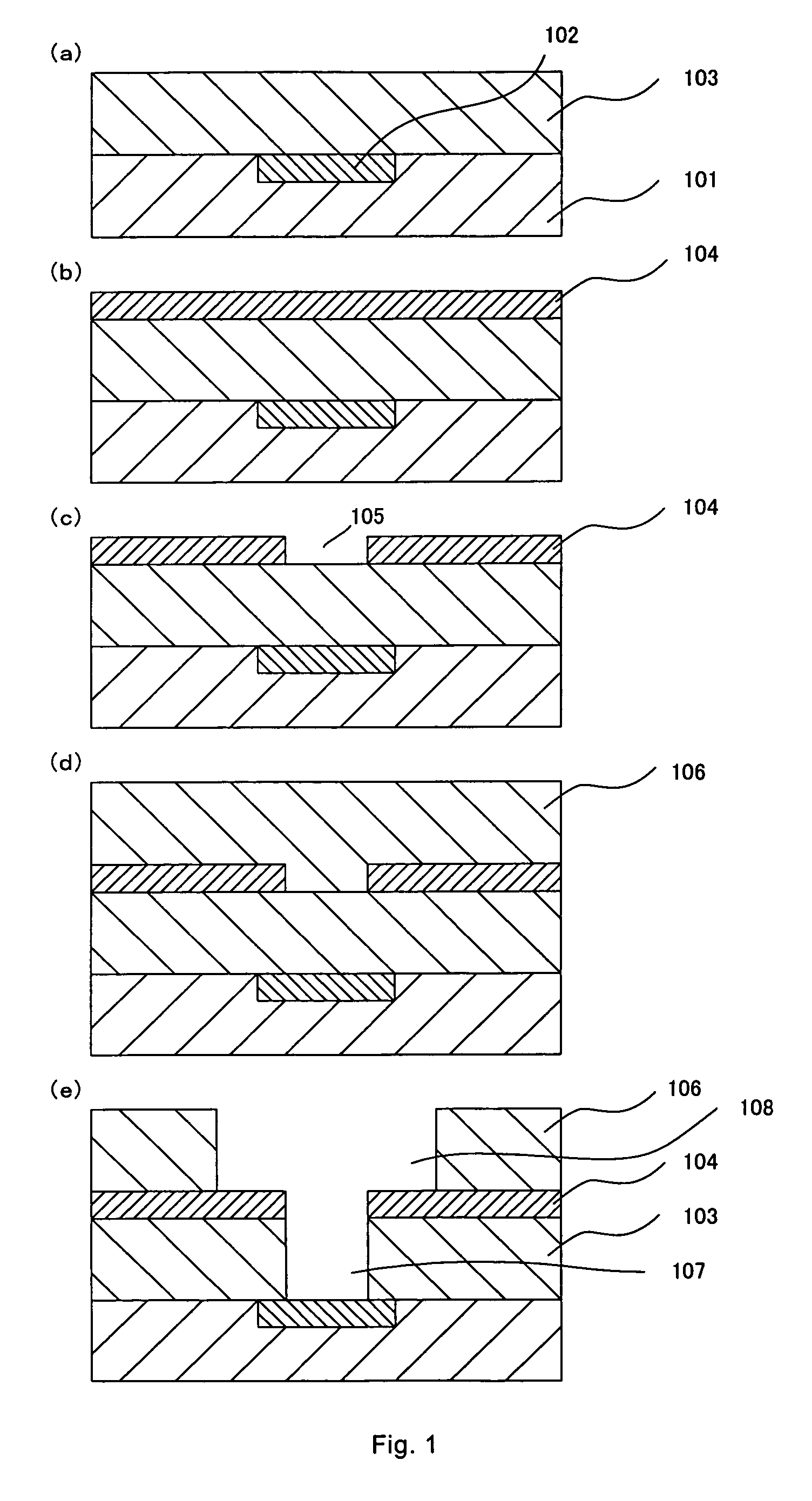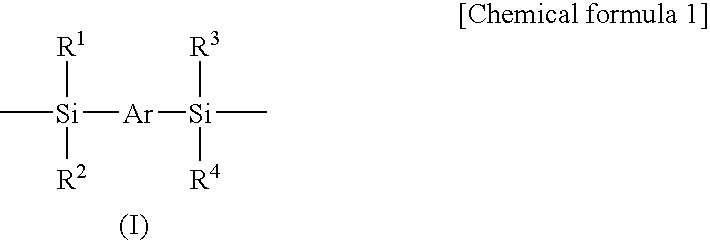Composition for forming etching stopper layer
a technology of etching stopper and composition, which is applied in the direction of coatings, electrical appliances, basic electric elements, etc., can solve the problems of difficult lowering of unsatisfactory etching resistance, and difficulty in providing satisfactory selectivity, so as to achieve high dry etching resistance and low permittivity , the effect of reducing the difficulty of lowering the permittivity of the whole elemen
- Summary
- Abstract
- Description
- Claims
- Application Information
AI Technical Summary
Benefits of technology
Problems solved by technology
Method used
Image
Examples
synthesis example 1
[0062] Synthesis was carried out in the same manner as in Comparative Synthesis Example 1, except that 105.75 g of phenyltrichlorosilane (PhSiCI3) and 39.4 g of 1,4-bis(dimethylchlorosilyl)benzene were used as starting materials. As a result, about 63 g of a highly viscous polymer 1 was obtained.
[0063] The molecular weight of this polymer 1 was measured. As a result, the number average molecular weight was 1500, and the weight average molecular weight was 4000.
[0064] FT-IR of this polymer 1 was measured. As a result, in addition to absorptions observed in polymer A prepared in Comparative Synthesis Example 1, absorption attributable to adjacent hydrogen of a benzene ring was observed around 780 cm−1. The adjacent hydrogen of this benzene ring is derived from 1,4-bis(dimethylchlorosilyl)benzene, that is, a disilylbenzene structure. This results of observation show that 1,4-bis(dimethylchlorosilyl)benzene was introduced into polymer 1. Further, in polymer 1, the content of silicon i...
synthesis example 2
[0065] The air in a reaction vessel installed within a thermostatic chamber was replaced by dry nitrogen. A solution of 47 g of phenyltrichlorosilane (PhSiCl3), 56 g of diphenyldichlorosilane (Ph2SiCl2), 3.8 g of methyldichlorosilane (MeSiHCl2), and 50 g of 1,4-bis(dimethylchlorosilyl)benzene dissolved in 1000 ml of xylene was then introduced into the reaction vessel. Next, the internal temperature of the reaction vessel was set to −5° C. When the temperature of the solution reached a predetermined temperature, a mixed solution, composed of water and pyridine, prepared by dissolving 13 g of water in 1000 ml of pyridine, was introduced into the reaction vessel at a rate of about 30 ml / min. In this case, upon the introduction of the mixed solution, a reaction of halosilane with water took place, and, consequently, the internal temperatuer of the vessel was raised to −2° C. After the introduction of the mixed solution composed of water and pyridine was completed, the reaction mixture w...
synthesis example 3
[0068] Polymer 3 having a disilylbenzene structure was synthesized in the same manner as in Synthesis Example 2, except that 66.3 g of methyltrichlorosilane was used instead of phenyltrichlorosilane and diphenyldichlorosilane. In polymer 3, the content of silicon in the disilylbenzene structure was 28.5% by mole based on the total number of moles of silicon contained in polymer 3. The content of carbon in polymer 3 was 25% by weight.
PUM
| Property | Measurement | Unit |
|---|---|---|
| temperature | aaaaa | aaaaa |
| temperature | aaaaa | aaaaa |
| temperature | aaaaa | aaaaa |
Abstract
Description
Claims
Application Information
 Login to View More
Login to View More - R&D
- Intellectual Property
- Life Sciences
- Materials
- Tech Scout
- Unparalleled Data Quality
- Higher Quality Content
- 60% Fewer Hallucinations
Browse by: Latest US Patents, China's latest patents, Technical Efficacy Thesaurus, Application Domain, Technology Topic, Popular Technical Reports.
© 2025 PatSnap. All rights reserved.Legal|Privacy policy|Modern Slavery Act Transparency Statement|Sitemap|About US| Contact US: help@patsnap.com



